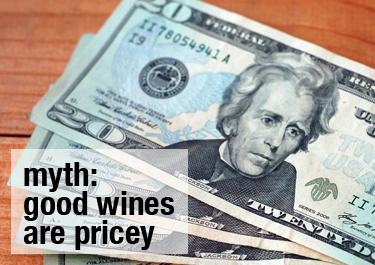Five Wine Myths Debunked.
With Valentine’s Day just around the corner, there’s no better time to start (or continue enjoying) a love affair with wine. While a little mystery can keep the sparks going, misunderstandings can damage or even end a romance. To help keep your relationship strong, The Hills Market wine counselors have put together a list of common myths that can get in the way of a fulfilling life together. As with many misconceptions, wine myths often tend to be based on reality, but some aspect has been misinterpreted or misconstrued. Below are the five most commonly encountered wine myths, according to our trusty staff of wine counselors.

1. There are no good wines under $20.
‘Love doesn’t cost a thing’ may not be applicable for wine, but the idea of having to spend a fortune for something good is equally untrue. Simply put, wine is something of a buyer’s market at the moment; with so many wines out there, it’s in a producer’s interest to keep pricing low. There seems to be an unstated misconception among some consumers that winemakers attempt to determine ‘How much they can get’ for a particular bottling when the process is finished. In reality, most producers have already decided a wine’s pricing ahead of time, based on the perceived quality of the property and scarcity of the grapes used. Yet much like vintage, even these factors can be overturned when a skilled winemaker puts forth a superior effort. So while there may be fewer “gorgeous” offerings under $20, they are out there, along with many good wines that are suitable everyday companions.
Constance says: We have an entire wall of wine less than $20 to prove this myth wrong! Many of them will surprise you with their nuanced flavors and layered complexity. Of course some of them are just plain delicious and are meant to be enjoyed as is—no pretenses.
Some values that might surprise you:
• Barnard Griffin Fumé Blanc 2009, Columbia Valley $9.99
• Montebuena Rioja 2009 $9.99

2. Vintage is everything.
Every year together is special, but it’s the quality of time spent that matters. Unless one is purchasing cases of wine for aging, vintage is really not a key point for consideration. With the majority of wines, care taken in production, soil type, and a winemaker’s techniques have far more bearing on quality than weather patterns. Most of what we consume on a daily basis comes from wineries that aim for a consistent product, rather than expressing vintage variation.
Michael says: Especially for wines less than $20, I pay little attention to the vintage year. I look at it like this – XYZ domestic automobiles might have its best year on the assembly line, but will that make its car as good as a BMW from that season? I’ve only noticed a marked difference between years on two occasions, and both involved the notoriously temperamental Viognier.
A couple of great wines from difficult vintages:
• Robert Stemmler Pinot Noir 2008, Carneros $29.99 ~Carneros suffered reduced crops with an uneven growing season this vintage
• Melini la Selvanella Chianti Classico Riserva 2005, $33.99 ~Rain in Tuscany during the critical time of harvest made this a difficult vintage

3. The older a wine, the better…
Not every wine is made for the long haul. In reality, the majority of wines intended for aging are heavyweight reds with high tannins, fortified wines such as Port and Madeira, and some notable exceptions like Burgundies and high end Champagne. Almost everything else loses something with age, and is meant to be consumed within the first few years of production. Most Whites, Rose’s and Zinfandels in particular are considered optimal wines when “young.”
Constance says: Who can hold on to a wine that long anyway?! There are many stats out there (like 90% of wine should be consumed within a year from release, less than 1% of wine produced is meant to be aged more than 10 years, 98% of wine is consumed within 48 hours of purchase), that contradict this long-lived myth. Old clichés die hard, though, so I often get asked how long a particular wine can age. Age-ability of a wine depends greatly on the grape variety, producer, quality, and vintage. Visit The Hills Market Wine Department for more information!
An aged wine to try:
• Broadbent Porto 2000 $50.99 ~still relatively young for Vintage Port which can age upwards of 40+ years
A young wine to try:
• A to Z Pinot Gris 2009, Oregon $14.99

4. Chardonnay equals oak.
Oak is a true defining point for one’s relationship with Chardonnays. Some love it, some can do without it completely. Fortunately for white wine lovers, Chardonnay comes in a variety of oak levels; ranging from oak-free steel cask, to strongly oaked varieties. While French Chardonnay generally exhibits no or very low oak levels (due to the age and nature of their barrels/grape acidity), domestics can rate on either end of the scale, or somewhere in between.
Michael says: There’s also a mini-myth that low/no oak Chard is by default sweet, or less sophisticated than its higher oak cousin. While a lack of wooden barrel aging can emphasize more fruit quality, there are many dry, sophisticated Chardonnays without a hint of oak.
Try These Light Oak/No Oak Chardonnays:
• Edna Valley Chardonnay 2008, San Luis Obispo County $12.99
• Lander Jenkins Chardonnay 2009, California $10.99
• 4 Vines Naked Unoaked Chardonnay 2009, Santa Barbara County $9.99

5. White Zinfandel is representative of all Rosés.
Making someone blush is a special thing. Blush (aka Rosé) starts out life as a red, but the sequence is interrupted; skins are removed, and the wine is then processed as a white. Despite its name, White Zinfandel is a Rose’ produced from the Zinfandel grape. An abundant yield in 1980’s California led to its popularity as a lower priced secondary offering. In contrast to the high alcohol, high sugar Zinfandel product, most Rose’ varietals result in a dry, sophisticated wine that possesses qualities of both reds and whites.
Constance says: There aren’t many categories of wine that are as versatile in food pairings as rosé wines; in part due to the fact that Rosé can be produced from any red grape variety. Perfected in the south of France, many rosés are produced from a blend of Grenache, Syrah, Mourvèdre and any number of grape varieties found in that area. Pinot Noir lovers will also find rosé incarnations of their favorite grape, as well as Cabernet Sauvignon and more recently, Malbec. Rosé wines tend to have light to medium body with lively fruit and bright acid, a key factor in food pairings—from salad to burgers!
Try These:
• Toad Hollow Dry Pinot Noir Rosé 2009, Sonoma $9.99
• Crios Malbec Rosé 2009, Mendoza $12.99
• Commanderie de la Bargemone 2009, Coteaux d’Aix en Provence $15.99






 Share Article
Share Article 


Reader Comments